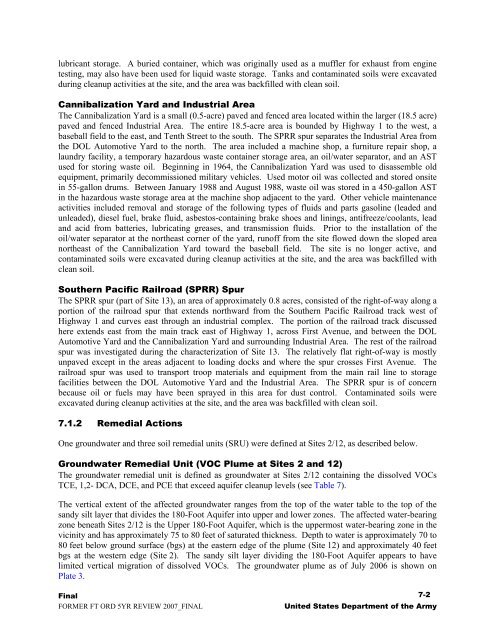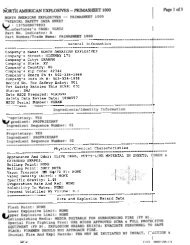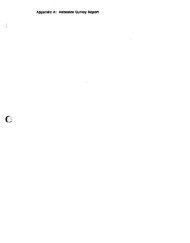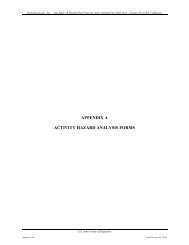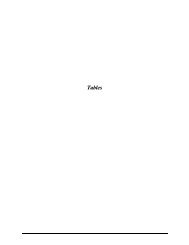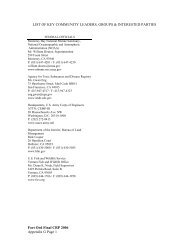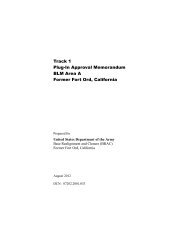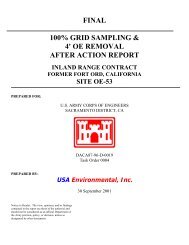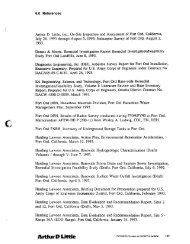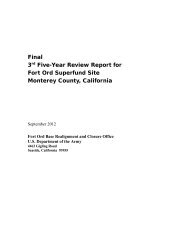Final Second Five-Year Review Report Fort Ord Superfund Site ...
Final Second Five-Year Review Report Fort Ord Superfund Site ...
Final Second Five-Year Review Report Fort Ord Superfund Site ...
Create successful ePaper yourself
Turn your PDF publications into a flip-book with our unique Google optimized e-Paper software.
lubricant storage. A buried container, which was originally used as a muffler for exhaust from engine<br />
testing, may also have been used for liquid waste storage. Tanks and contaminated soils were excavated<br />
during cleanup activities at the site, and the area was backfilled with clean soil.<br />
Cannibalization Yard and Industrial Area<br />
The Cannibalization Yard is a small (0.5-acre) paved and fenced area located within the larger (18.5 acre)<br />
paved and fenced Industrial Area. The entire 18.5-acre area is bounded by Highway 1 to the west, a<br />
baseball field to the east, and Tenth Street to the south. The SPRR spur separates the Industrial Area from<br />
the DOL Automotive Yard to the north. The area included a machine shop, a furniture repair shop, a<br />
laundry facility, a temporary hazardous waste container storage area, an oil/water separator, and an AST<br />
used for storing waste oil. Beginning in 1964, the Cannibalization Yard was used to disassemble old<br />
equipment, primarily decommissioned military vehicles. Used motor oil was collected and stored onsite<br />
in 55-gallon drums. Between January 1988 and August 1988, waste oil was stored in a 450-gallon AST<br />
in the hazardous waste storage area at the machine shop adjacent to the yard. Other vehicle maintenance<br />
activities included removal and storage of the following types of fluids and parts gasoline (leaded and<br />
unleaded), diesel fuel, brake fluid, asbestos-containing brake shoes and linings, antifreeze/coolants, lead<br />
and acid from batteries, lubricating greases, and transmission fluids. Prior to the installation of the<br />
oil/water separator at the northeast corner of the yard, runoff from the site flowed down the sloped area<br />
northeast of the Cannibalization Yard toward the baseball field. The site is no longer active, and<br />
contaminated soils were excavated during cleanup activities at the site, and the area was backfilled with<br />
clean soil.<br />
Southern Pacific Railroad (SPRR) Spur<br />
The SPRR spur (part of <strong>Site</strong> 13), an area of approximately 0.8 acres, consisted of the right-of-way along a<br />
portion of the railroad spur that extends northward from the Southern Pacific Railroad track west of<br />
Highway 1 and curves east through an industrial complex. The portion of the railroad track discussed<br />
here extends east from the main track east of Highway 1, across First Avenue, and between the DOL<br />
Automotive Yard and the Cannibalization Yard and surrounding Industrial Area. The rest of the railroad<br />
spur was investigated during the characterization of <strong>Site</strong> 13. The relatively flat right-of-way is mostly<br />
unpaved except in the areas adjacent to loading docks and where the spur crosses First Avenue. The<br />
railroad spur was used to transport troop materials and equipment from the main rail line to storage<br />
facilities between the DOL Automotive Yard and the Industrial Area. The SPRR spur is of concern<br />
because oil or fuels may have been sprayed in this area for dust control. Contaminated soils were<br />
excavated during cleanup activities at the site, and the area was backfilled with clean soil.<br />
7.1.2 Remedial Actions<br />
One groundwater and three soil remedial units (SRU) were defined at <strong>Site</strong>s 2/12, as described below.<br />
Groundwater Remedial Unit (VOC Plume at <strong>Site</strong>s 2 and 12)<br />
The groundwater remedial unit is defined as groundwater at <strong>Site</strong>s 2/12 containing the dissolved VOCs<br />
TCE, 1,2- DCA, DCE, and PCE that exceed aquifer cleanup levels (see Table 7).<br />
The vertical extent of the affected groundwater ranges from the top of the water table to the top of the<br />
sandy silt layer that divides the 180-Foot Aquifer into upper and lower zones. The affected water-bearing<br />
zone beneath <strong>Site</strong>s 2/12 is the Upper 180-Foot Aquifer, which is the uppermost water-bearing zone in the<br />
vicinity and has approximately 75 to 80 feet of saturated thickness. Depth to water is approximately 70 to<br />
80 feet below ground surface (bgs) at the eastern edge of the plume (<strong>Site</strong> 12) and approximately 40 feet<br />
bgs at the western edge (<strong>Site</strong> 2). The sandy silt layer dividing the 180-Foot Aquifer appears to have<br />
limited vertical migration of dissolved VOCs. The groundwater plume as of July 2006 is shown on<br />
Plate 3.<br />
<strong>Final</strong><br />
7-2<br />
FORMER FT ORD 5YR REVIEW 2007_FINAL United States Department of the Army


